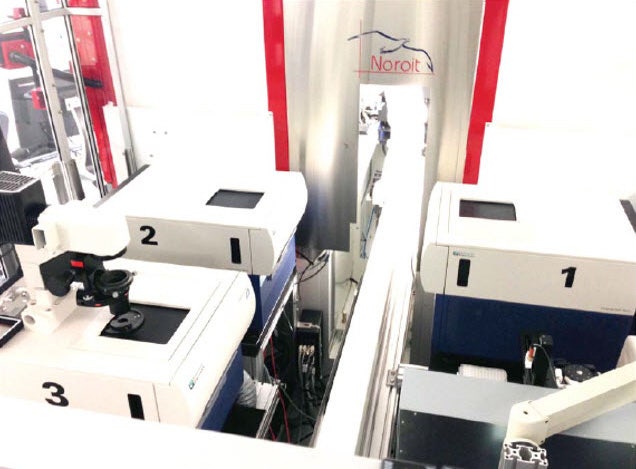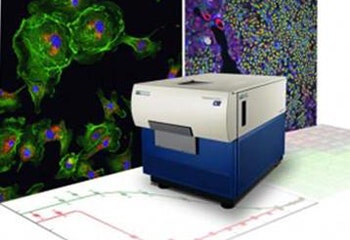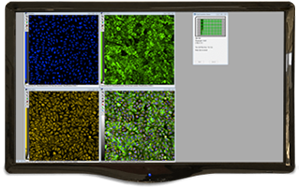
Gustave Roussy Cancer Center uses the ImageXpress Widefield Systems to assess mechanisms of cell stress and death in cancer treatment
"We carefully screened the market and tested most of the available systems." OLIVER KEPP
COMPANY/UNIVERSITY
Kroemer Lab, Cell Biology Platform, Gustave Roussy Cancer Center, Paris, France
TEAM MEMBERS
Research Director: Guido Kroemer
Team Leader: Oliver Kepp
Faculty members: Allan Sauvat, Marion Leduc
PRODUCTS USED
MetaXpress High-Content Image Acquisition and Analysis Software
ImageXpress Micro XLS Widefield High-Content Analysis System
The Challenge
The Kroemer Lab is interested in the molecular mechanisms of cellular stress and death. The mode of cellular stress and death that is evoked during cancer treatment has profound therapeutic implications. A systematic search has been launched to identify molecular switches that “decide” which particular cell stress or cell death subroutine is preferentially executed. In addition, cancer cell death modalities and their impact on the immune system are analyzed in a systematic fashion to develop strategies that improve the chances of therapeutic success.
The Cell Biology platform (pictured, right) within the Kroemer Lab is used as a hub to conduct screening approaches as it offers fully automated cell biology workflows that allow for the phenotypic screening of large-scale compound and siRNA libraries. They use a battery of fluorescent biosensor cells to assess all types of cellular stress and death.
To enable this cutting-edge research, the group needed a high-content analysis system that they could fully integrate into an automated platform which also includes compound management and automated cell culture.

The Solution
The group carefully screened the market and tested most of the available systems before deciding on the ImageXpress® Micro XLS Widefield High-Content Analysis System. They currently have five ImageXpress systems within the group, two of which are permanently integrated into their automated platform, one which can be moved in or out of the platform as needed, and two stand-alone systems equipped with environmental control that allow them to validate findings from the screening platform in live cell assays and on microfluidic devices.
The configuration that they decided on allows them to use multibandpass filters in combination with powerful LED light engines, which makes the acquisition extremely fast as it minimizes mechanical movements.
Speaking about the platform, Kepp said, “The integration of the ImageXpress systems allowed us to create a solution that offered speed - due to the two identically built machines working in parallel on the platform, and reliability - due to the redundancy that they created”.
For data acquisition and analysis, the team uses MetaXpress® High-Content Image Acquisition and Analysis Software in combination with custom-built R algorithms.

ImageXpress Micro XLS Widefield High-Content Analysis System

MetaXpress High-Content Image Acquisition and Analysis Software
Products Used
Capture images of whole organism and cellular or intracellular events
The ImageXpress Micro XLS High-Content Analysis System has been replaced by the ImageXpress Micro 4 High-Content Analysis System, which represents the culmination of four generations of imaging expertise. The latest agile design allows you to boost your research with this faster-than-ever system, while providing the option to upgrade to confocal in the future to align with your research needs.
The Results
The unique design of the group’s platform allows for extremely flexible assay design and multiplexing as it integrates automated cell culture and compound management with three fully automated high content analysis systems via an industrial robot.
“We find the ImageXpress system and MetaXpress software are reliable and easy to use. We coded all necessary data mining tools in R using the SQL database in which MetaXpress stores information. This approach allows us to go from image to bar chart in minimum time, which is something we could not do before with our old imaging system”, said Kepp
The throughput for a whole genome screen is 67 x 384 plates and the platform does a whole genome screen in a week. Apart from the siRNA screening, the automation is mainly used for screening compound libraries in different dimensions (concentration, time, combinations).
As an example of the type of research that this technology is enabling, the group was recently able to show that trans fats inhibit autophagy induced by saturated fatty acids (image).

References
Recent Publications
1) Sauvat A., et al. (2018). Trans-Fats Inhibit Autophagy Induced by Saturated Fatty Acids. EBioMedicine. pii: S2352-3964 (18) 30115-4. [Epub ahead of print].
2) Bezu L., et al. (2018). eIF2α phosphorylation is pathognomonic for immunogenic cell death. Cell Death & Differentiation. [Epub ahead of print].
3) Liu P., et al. (2017). Identification of pharmacological agents that induce HMGB1 release. Scientific Reports, 7 (1): 14915.
4) Sauvat A., et al. (2017). Automated Analysis of Fluorescence Colocalization: Application to Mitophagy. Methods in Enzymology, 588: 219-230.
5) Zhou H., et al. (2016). The oncolytic compound LTX-401 targets the Golgi apparatus. Cell Death & Differentiation, 23 (12): 2031-2041.